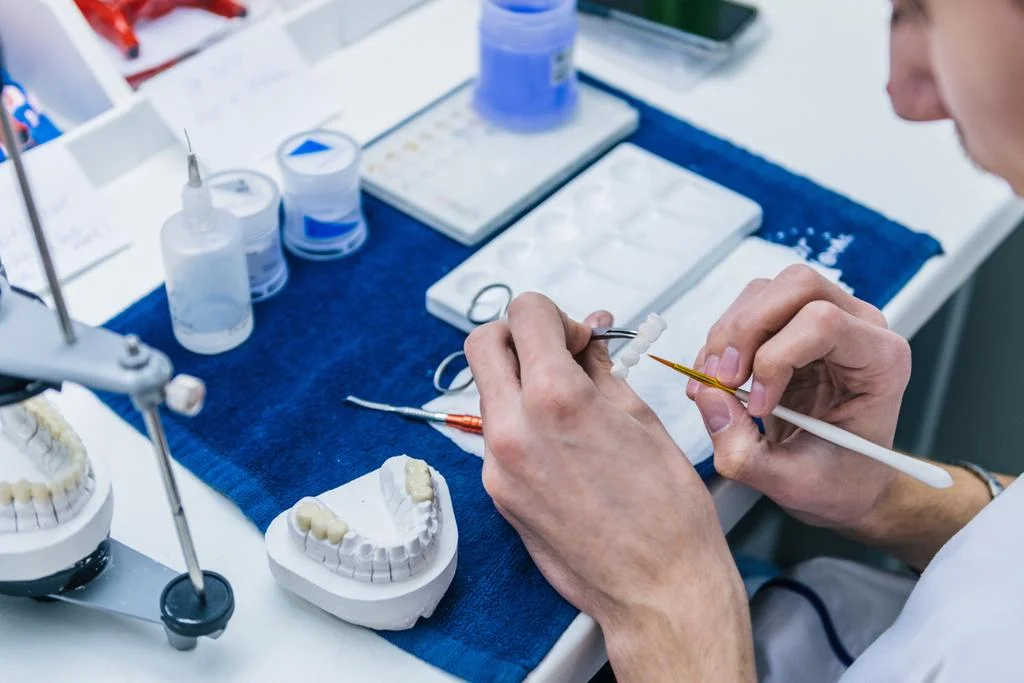Dental crowns help restore damaged or decayed teeth, protecting the remaining tooth structure and appearance. Large cavities, fractures, discoloration, or other issues can compromise the natural crown cap on teeth. Durable porcelain, ceramic, and metal materials mimic natural crowns. Skilled dental lab technicians handcraft customized restorations to match patient tooth shades and contours. Advanced digital workflows combine artistry with precision for functional dental crowns. Here’s how dental crowns are made in a professional lab:
Taking Impressions
The dental crown fabrication process begins in the operatory with accurate tooth impressions. Dentists select impression trays that fit the area needing restoration. Once loaded with fast-setting putty, the trays capture detailed physical mold once they are seated over the teeth. Impressions make a hollow duplicate of the tooth requiring a crown alongside adjacent teeth. Soft tissues, opposing arches, and bite registration are also recorded for appropriate crown contours and occlusion. Completed impressions contain physical tooth data that is then sent to the lab.
Crown Design
From physical or digital tooth impressions, dental lab technicians generate 3D digital crown models that match prescription parameters. Sophisticated CAD software and advanced milling equipment create models detailing the prepared tooth structure and adjacent teeth. Technicians manipulate files to establish ideal margins, contacts, contours, and occlusion before fabricating the final crown. Digital renderings give labs artistic control to address complex dental cases as needed. They make design adjustments based on years of combined clinical experience and training to create functional, reliable restorations.
Material Selection
Technicians include material guidelines along with original dentist prescriptions in finalized digital crown models. They select design-matched blocks to meet prescribed function, transparency, and tooth shade needs. Stock inventories offer various core colors and layering porcelains, which technicians mix, blend, and customize per patient. For short-term crowns protecting the designated teeth until permanent replacement, they might choose softer temporization materials. Technicians base their material selection on case complexity and longevity goals within the oral environment.
Unit Fabrication
Technicians upload validated crown models to onsite milling systems for automated fabrication. The systems cut full-contour restorations from selected material blanks loaded in chambers. As directed by the 3D renderings, diamond-tipped burs then carve fine crown details. Digital workflows enable the creation of multiple accurate units from single-source models in condensed timeframes. Inspectors check milled crowns relative to digital models before final artistry, bonding, and shipping.
Handwork Artistry
While advanced systems excel at fabricating crown substructures, handwork artistry brings restorations to more lifelike refinement. Based on years of sculpture experience, master technicians perform detailed handwork to add depth, textures, and shading to reflect the surrounding dentition. Technicians can adjust contacts for fit without food impaction points. They make adjustments to approved models as needed to satisfy prescription requirements.
Quality Assurance Testing
Technicians also perform final validations of finished dental crowns to make sure they are compliant with the prescription. They compare the units to the original models, verifying the accuracy of fit, contacts, bite occlusion, and cement gaps. Experts can assess surface smoothness and material integrity by touch and sight from multiple angles. They evaluate shades next to patient photographs under color-neutral lighting. Once bonded into place, technicians can help approved crowns seamlessly integrate with remaining teeth without detectable margins.
Case Completion and Shipping Preparation
Validated dental crowns are then cleaned, polished, and prepped for dentist delivery. Units are labeled by tooth and packaged to prevent damage during shipping. Prescriptions, shade references, photos, and invoices are enclosed, detailing case instructions should temporary remakes ever be needed. Digital images give dentists preview access before scheduled patient seating dates. Completed case boxes are dispatched for direct pickup or overnight shipping return to dental offices. Digital workflows allow for virtual case completion notifications instead of solely relying on physical product transport.
Visit a Dental Lab Today
Dentists evaluate finished crowns before permanently bonding them into place. The fit, contacts, and occlusion are all verified intraorally before isolation and cementation. Minor adjustments eliminate microscopic binding spots that could undermine durability. Approved crowns are permanently fixed using dental adhesives, losing retainers, or temporary covers. Shade matches may restore bright smiles by blending replacement crowns with surrounding natural dentition. Contact a dental lab today to find out more about dental crowns.


